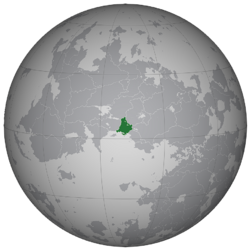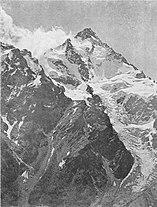Hondonia
This article is incomplete because it is pending further input from participants, or it is a work-in-progress by one author. Please comment on this article's talk page to share your input, comments and questions. Note: To contribute to this article, you may need to seek help from the author(s) of this page. |
The Republic of Hondonia | |
|---|---|
| Motto: "L'ounitai fai le force" (Hondonian) ("Unity makes strength") | |
| Anthem: "Le marx de l'ounitai" (Hondonian) | |
 Hondonia in Thuadia | |
| Capital and largest city | Sant-Demir-Sier-Mar (Sant-Demir) |
| National language | Hondonian |
| Official languages | |
| Ethnic groups (2011) | see here
|
| Religion (2011) | |
| Demonym(s) | Hondonian |
| Government | Unitary semi-presidential republic |
• President | Micail Berbicareisc |
• Prime Minister | Petre Ferare |
| Legislature | Le Paraul Grand |
| [PLACEHOLDER] | |
| [PLACEHOLDER] | |
| Establishment history | |
• Independence | 8 January 1822 |
• 1st Unification | 5 December 1878 |
• 2nd Unification | 1 August 1955 |
• 3d (last) Unification | 12 March 1961 |
• Current Constitution | 20 April 1989 |
| Area | |
• Total | 368,767 km2 (142,382 sq mi) |
| Population | |
• 2022 estimate | |
• 2011 census | 17,419,142 |
• Density | 47/km2 (121.7/sq mi) |
| GDP (PPP) | 2021 estimate |
• Total | ( ( |
• Per capita | ( ( |
| GDP (nominal) | 2021 estimate |
• Total | ( ( |
• Per capita | ( ( |
| Gini (2020) | medium |
| HDI (2020) | high |
| Currency | Dinare Hondon (Ð - HRD) Sekinar (ᕋ - SEK) |
| Time zone | UTC-5 |
| Date format | dd.mm.yyyy |
| Driving side | right |
| Calling code | +37 |
| ISO 3166 code | HD |
| Internet TLD | .hd |
Hondonia ([hɔnˈdoniə] ; Hondonian: Ondonie ([ɔ̃ˈdonjə]
; Bogmian: [Placeholder]; Brailian: Hotonọsehéné ([hʊtʊnʰʊ̥s̠ɪhɪ́né]); Fodhlan: Ondoin ([ˈon̪ˠd̪ˠonʲ]); Myacha: Òntónta Mêykěyǔ [oˀn˨˩toˀn˦˥.tɐˀ˥ meˀj˥˦˩ ke˩˨˥ ju˩˨˥]}), officially known as The republic of Hondonia, is a country located in the Laurantine Gulf in south Thuadia. It borders the Laurantine Gulf to the south, [PLaceholder] to the southeast, Mustelaria to the east, [PLaceholder] to the northeast, Tiskaiya to the north, and Liturlania to the west. The nation is comprised of 13 provinces and the Sant-Demir capital district. Hondonia covers an area of 368,767 square kilometers (142,382 sq mi), with a population of around an estimated 18 million.
Hondonia has been inhabited by various indigenous people since at least 30,000 BCE, including the Heiyin, Myacha and the Brailian. Moldanians landed on Birds' island (Hondonian: Ensul dei Paçar) in the 17th of April 1578, and a month later on the coast of what became the colony of New Roumania (Hondonian: Noù Roumanie). By the mid-17th century the colony grew to what is majority of today's Hondonia, with Sant-Demir-Sier-Mar as it's administrative and economic capital. Independence from the Moldanian crown was achieved on the 8th of January of 1826, with what is now Hondonia emerging as the Free Kingdom of New Roumania (Hondonian: Lier Pai de Noù Roumanie), later the country would be renamed to Hondonia to distance themselves from the Principality of Moldania. In the following century the country saw numerous internal armed conflicts primarily due to ideological factions leading to the Hondonian waring states era. On the 12th on March of 1961 the current Republic of Hondonia was founded, and has seen an increase in stability over the next decades. On June 5th 2008 Hondonia joined the Sekidean Union. During the past decades the country had been at it's golden age, even though it still strugles with cases of corruption and instability in some of it's provinces.
Etymology
The name "Hondonia" is derived from the last name of the half Hondonian (then known as Vlachs, however they are not related to the actual Vlach people in Moldanian) - half Moldanian explorer Michael Hondonescu (Moldanian: Mihai Hondonescu; Hondonian: Micail Ondonisc), who, along with a group of other explorers, helped explore the Hondonian inland. After the independance of the New Roumania colony from the Principality of Moldania in 1822, it was renamed to Hondonia (Hondonian: Ondonie) after the explorer, and the people started calling themselves and the language they spoke Hondonian (Hondonian: Ondon, Leng d'Ondon) to distance themselves from the Moldanian empire.
History
Prehistory
Indigenous people inhabited the territory of modern day Hondonia by at least around 30,000 BCE, various hunter-gatherer societies existed near the present-day province of Noù Roumanie de Sied, they traded with one another and with cultures living in the Sant-Demir river valley. The oldest archaeological finds are from the Maur Caul archaeological site and Çare Aub archaeological site in the Sant-Demir river valley 100 kilometres (62 mi) northeast of Sant-Demir-Sier-Mar in the Noù Roumanie de Sied province, these sites date from ~30,000-10,000 BCE. At Maur-Petre archaeological site and other sites, traces from the Archaic period in Hondonia (~10,000–2,000 BCE) have been found. Vestiges indicate that there was also early occupation in the regions of [Placeholder], [Placeholder] and [Placeholder] in the Tunitrian mountains. The oldest pottery discovered in Hondonia, found at [Placeholder] archaeological site, dates to ~9,000–7,000 BCE.
Pre-Colonization
Around the year 861 the Tùocóng Empire was founded around modern day Riè dei Lop on the coast of lake [Placeholder] with the annexation of the Pàcóng kingdom by the aformentioned Tùocóng, both kingdoms belonging to the Myacha people. The empire spred accross the Tunitrian mountains, conquering majority of the mountain range by around the year 1008. The Brailian tribes didn't have a unified state however they engaged in tribal unions and were therefore able to stay independant from teh Tùocóng Empire, though the Empire prooved influencial to the southern tribes.
During the same time on the coast of modern day Hondonia, the coastal Heiyin kingdom of Reuceu, under the rule of [Placeholder] the Great, was able to subjugate most of the Heiyin kingdoms under one flag, ending the era of waring kingdoms. Various smallers tribal states started appearing in the savannas and jungles of Hondonia. The Reuceu kindom remained peacefull for two centuries untill the Kairi island rebelion which resaulted in the independence of the Kairi kingdom and various smaller rebelions in Hrastmozh and Jultxe island.
In the late 14th century the Tùocóng empire fell into a civil war due to unrest with the raised taxes implimented by [Placeholder], the emperor at the time. The war was fought by the Loyalists supporting the [Placeholder] (also spelled as [Placeholder], the title used for a ruler of the Tùocóng empire), and the Reds, called so due to the red bands they wore to identifie themselves, who opposed the current [Placeholder]. The Brailian regions were particulary against [Placeholder] [Placeholder], they were able to reach victory in the northern regions and establish a new kingdom, known as the [Placeholder] kingdom, while the southern areas were able to fend them off and remain the empire. The [Placeholder] and the Tùocóng empire engaged in various conflicts and wars for influence over tribes in the feet of the mountains controlled by each nation over the next decades.
Colonization
Geography
It is known as Tào Yì Myâ in Myacha, and Tàu Yè Ɦǫ̀ in the local Toga (Ghoga) dialect, it was also known in the western reaches of the Tùocóng empire in the local for that region Ghacya (Dzocya) dialect as Tào Zyè Ɦàn.
Climate
Biodiversity
Government and politics
Foreign affairs
Military
Administrative divisions
| Provinces of Hondonia | |||||||||||||||||||||||||||||||||||||||||||||||||||||||||||||||||||||||||||||||||||||||||
|---|---|---|---|---|---|---|---|---|---|---|---|---|---|---|---|---|---|---|---|---|---|---|---|---|---|---|---|---|---|---|---|---|---|---|---|---|---|---|---|---|---|---|---|---|---|---|---|---|---|---|---|---|---|---|---|---|---|---|---|---|---|---|---|---|---|---|---|---|---|---|---|---|---|---|---|---|---|---|---|---|---|---|---|---|---|---|---|---|---|

Cost dei Pluei [Placeholder] (Mẹtseyenọsehéné) Sant-Demir- Sier-Mar Frontarici Ensul de Jultxe Micailici [Placeholder] [Placeholder] Noù Roumanie de Nord Noù Roumanie de Sied [Placeholder] (Pomẹtsevọsehéné) Tuçong [Placeholder] Taiamenie | |||||||||||||||||||||||||||||||||||||||||||||||||||||||||||||||||||||||||||||||||||||||||
| |||||||||||||||||||||||||||||||||||||||||||||||||||||||||||||||||||||||||||||||||||||||||
Largest settlements
Economy
Demographics
Ethnic groups
Languages
Religion
Culture
Literature
Visual arts
Music
Popular culture
Cuisine
Sports
Healthcare
Education
See also



